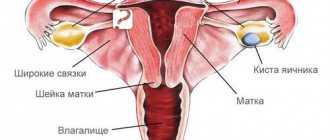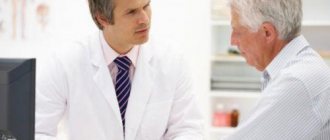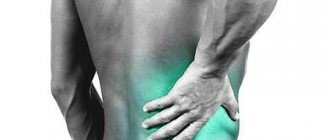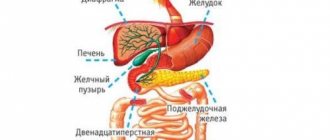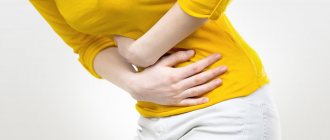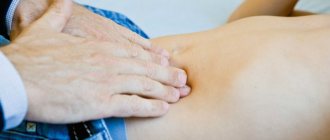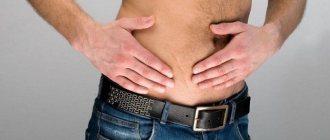Pain in the intestines on the right and left side of the lower abdomen can be caused by various reasons. This symptom is typical for people who have gastroenterological, gynecological and urological diseases. Pain in the intestines on the right and left side of the lower abdomen indicates pathologies in the pelvis. At the first complaint, the patient should contact a medical expert. At the private clinic “KDS Clinic”, specialists will conduct an initial examination, give advice and refer you for a diagnostic examination. We will help you determine the cause of the disease and select an individual treatment program.
Severe pain inside the abdomen is a clear sign of diseases that affect the large or small intestine. The process of spasms leads to the accumulation of lactic acid in the body, which irritates the nerve endings and causes pain.
Severe pain in the intestines is the result of poor nutrition, a side effect after taking medications, or an inflammatory process. Inflammatory processes in the intestines are accompanied by pain, nausea, bloating, colic and bad bowel movements.
Determining the cause of pain by symptoms
The table was compiled by Victoria Druzhikina, a practicing therapist on the AskVracha website, and serves as the most reliable source of information when determining the cause of pain.
| Disease | Symptom | Drugs used |
| Acute cholecystitis | Acute, severe pain radiating downwards, nausea, vomiting, fever, loose stools. | Antispasmodics (Duspatalin, No-shpa, Papaverine); Antibiotics (Ciprofloxacin, Amikacin, Meropenem); Analgesics (Diclofenac, Ketorol); Antacids (Famotidine, Omeprazole, Rabeprazole). |
| Chronic cholecystitis | Most often dull, aching, paroxysmal pain, intensifying after fatty foods, rarely - pronounced, loose stools. | Antispasmodics (“Duspatalin”, “No-shpa”, “Papaverine”); Antibiotics (“Ciprofloxacin”, “Amikacin”, “Meropenem”); Analgesics (“Diclofenac”, “Ketorol”); Antacids (Famotidine, Omeprazole, Rabeprazole). |
| ZhKB | Sharp, cutting pain, nausea, vomiting, yellowing of the skin, loose stools" | Antispasmodics (“Duspatalin”, “No-shpa”, “Papaverine”); Antibiotics (“Ciprofloxacin”, “Amikacin”, “Meropenem”); Analgesics (“Diclofenac”, “Ketorol”); Antacids (Famotidine, Omeprazole, Rabeprazole), surgery |
| Hepatitis | The pain is strong, but dull, and may be nagging. Nausea, vomiting, fever, loose stools, weakness, sweating. | Specific antiviral therapy. |
| Cirrhosis of the liver | Dull, in the final stage severe pain, ascites (fluid in the abdominal cavity, looks like a bulging belly), yellow-brown tongue, weakness, nausea, vomiting, loose stools, heaviness in the right side. The protruding edge of the liver is often visible from under the ribs. In the final stage, the organ shrinks and stops protruding. | Hepatoprotectors (“Heptral”, “Ursosan”, “Ornithi”n, milk thistle extract); Proton pump inhibitors (Omeprazole, Rabeprazole, Esomeprazole); Anticholinergic drugs (Mebeverine, Trimebutine). |
| Appendicitis | Many faces - pains are sharp, dull, strong, weak, from the navel to the level of the sternum. Nausea, single vomiting. Fever. Loose stools. Mixing of pain from the epigastrium to the right iliac region after 3–4 hours from the onset (Kocher’s symptom). | Surgery |
| Enteritis, colitis | Pain along the intestines, rumbling in the abdomen, bloating, blood and mucus in the stool. The stool is irregular, liquid. | Antispasmodics (“No-shpa”, “Papaverine”); Antidiarrheal ("Smecta") |
| Bowel cancer | The pain is aching at first, then severe. Constipation, obstruction, weight loss. | Surgical treatment, chemotherapy, radiation |
| Nephroptosis | The pain is often associated with sudden movements, especially high jumps. Varying intensity, usually medium. | Kinesiology. Osteopathy. Surgical correction – kidney suturing |
| Osteochondrosis | The pain comes from the spine and intensifies with movement, inhalation, and coughing. At rest I subside or decrease. | NSAIDs (“Meloxicam”, “Xefocam”, “Diclofenac”, “Aertal”); Muscle relaxants (“Sirdalud”, “Mydocalm”); Chondroprotectors (“Teraflex”, “Dona”, “Arthra”); B vitamins (“Neurobion”, “Combilipen”, “Milgamma”). |
| Endometriosis | The pain is quite intense and is accompanied by cycle disruption and bleeding. | Surgery; Hormonal drugs. |
| Bruise, injury | Pain is associated with a fall, blow, etc., and is limited by this impact. Intensifies with pressure. Accompanied by the formation of a hematoma and bruise. | NSAIDs (Meloxicam, Xefocam, Diclofenac). |
| Myositis | Pain in the muscle, intensifies with pressure and movement. Quite noticeable, subsides when resting. | NSAIDs (“Meloxicam”, “Xefocam”, “Diclofenac”, “Aertal”); Muscle relaxants (“Sirdalud”, “Mydocalm”); |
Lesions and gallbladder
The liver and gallbladder are critically important internal human organs. Even the slightest disruption to their work can lead to serious consequences. Regular nagging pain in the right side at waist level may indicate that a pathology of these organs is developing.
Cholecystitis (Inflammatory process in the gallbladder)
It is usually a natural complication of developed gallstone disease and is associated with a disruption of the organ’s ecosystem. In most cases, cholecystitis develops in the presence of stones in the gall bladder. The inflammatory process develops rapidly in the acute form and relatively sluggishly in the chronic form.
Treatment of cholecystitis against the background of cholelithiasis is carried out by a surgeon, without cholelithiasis - by a therapist or gastroenterologist.
In the photo: the formation of stones in the gall bladder
Cholelithiasis
Mineralization processes in the gallbladder lead to the appearance of stones and inflammation. Organ tissues turn yellow
If the formed stones block the free flow of bile, then acute pain appears in the side. If the condition worsens, you must call an ambulance.
There is a wide range of drugs available for drug therapy. These include ursodeoxycholic acid (UDCA) and its generics. In cases where the outlet for bile is blocked, the stone has gone into the duct, surgical intervention is performed to remove the stones. A surgeon treats diseases.
Hepatitis
Hepatitis A, B and C are infectious acute diseases that can lead to significant problems and subsequent complications. Often, pain in the right side is a potential symptom of the disease.
In addition to pain, fever, weakness, aching joints, and an increase in the size and weight of the spleen and liver are possible. For conservative treatment use:
- for hepatitis C, direct-acting antiviral drugs;
- for hepatitis B nucleotides/nucleosides;
- for A and B – vaccination;
- it is possible to use vitamin complexes and hepatoprotectors.
If the symptoms are similar, a general practitioner will be able to identify the disease and prescribe therapy.
Cirrhosis of the liver
Any pain at the waist level should be taken seriously. At waist level are the major vital organs, including the liver. Rapid acute intoxication of the organ and prolonged exposure to toxins can lead to tissue destruction and cirrhosis.
The disease quickly becomes chronic and the damage becomes irreversible. Therapy comes down to maintaining the function of the organ using all possible medications. If you suspect liver pathology, you can consult a hepatologist.
Irritable bowel syndrome (IBS)
This condition is not associated with changes in the structure of organs and systems. However, pain with irritable bowel syndrome is almost always observed and is a common symptom overall. Women usually suffer from IBS more often than men. Pain (from moderate to severe) can cover the lower abdomen, including the right side, but is most often localized on the left9. IBS often develops against the background of psychoemotional disorders10.
Symptoms of the disease usually subside in the evening and do not bother patients at night. The pain in some cases spreads to the upper abdomen, radiating to the rectum and epigastric region9-11. An important role in the formation of complaints is played by impaired intestinal motility, accompanied by spasm. As part of complex therapy for IBS, antispasmodics (for example, No-shpu® and No-shpu® forte) can be used, which helps reduce pain7, 12, 22.
Gastrointestinal pathologies
The main parts of the gastrointestinal tract system are located in the abdominal cavity, and therefore they often become the cause of pain syndromes
Inflammation of the appendix (Appendicitis)
In scientific circles, appendicitis is an inflammatory process with a focus in the appendix with the accumulation of pus inside the appendix at the narrowed bottom. This can not only cause pain in the right side at the waist level, but also many other unpleasant symptoms.
The disease develops rapidly, and acute forms are fraught with fatal outcomes. Localization of pain in the right side or bottom is sometimes caused by pylephlebitis (this is an inflammatory process involving the portal vein, which leads to direct damage to the liver).
A consultation with a surgeon will help confirm suspicions of appendicitis.
Intestinal inflammation
Disruption of the microflora, bacterial and viral invasions, as well as the entry of foreign objects into the intestines provoke inflammation. The disease is accompanied by defecation disorders, the appearance of stool mixed with mucus or blood, flatulence and pain of various types.
For treatment, if necessary, antibiotics of different groups are used, depending on the disease (Enterofuril, Oleandomycin, Amoxicillin, etc.).
Oncological diseases of the intestine
Nowadays, cancer is detected quite early. Colonoscopy and MRI can identify suspicious clusters of cells and quickly reveal their nature. If you notice symptoms (pain, change in color of stool, defecation disorders), you should immediately consult a doctor.
The therapeutic plan is developed depending on the stage of the cancer. It is possible to use chemotherapy or surgical removal of malignant tissue. Read about polyps in the intestines here.
Treatment
Help before diagnosis
Mild pain in the right side associated with hypothermia or physical activity does not require drug treatment. Mostly they go away on their own after 1-3 days. If the pain syndrome bothers you for a long time or the intensity of the pain increases quickly, you should immediately seek medical help. For excruciating pain, the doctor uses analgesics at the prehospital stage.
Conservative therapy
To relieve pain, nonsteroidal anti-inflammatory drugs, narcotic analgesics, and antispasmodics are used in practical medicine. For quick pain relief, blockades are made with local anesthetics. These measures provide a temporary effect, so subsequently, to eliminate pain in the right side, etiotropic therapy is prescribed that affects the underlying disease. The following groups of medications are used in surgery and gastroenterology:
- Anti-inflammatory drugs.
Inflammation is controlled not only by classic NSAIDs, but also by 5-aminosalicylic acid derivatives and corticosteroid hormones. - Probiotics.
Medicines are needed to restore microflora and normal intestinal function, which helps reduce pain and eliminate dyspeptic disorders. - Infusion solutions.
Necessary for correcting dehydration of the body, removing toxic breakdown products from the blood, maintaining normal hemodynamic parameters. - Antibiotics.
The drugs are prescribed for generalized forms of salmonellosis, for the prevention of purulent complications of inflammatory diseases of the digestive organs. - Cytostatics.
Taken for severe forms of Crohn's disease when hormonal therapy is ineffective. They are also included in chemotherapy regimens used for malignant neoplasia of the colon.
To improve the patient's condition, symptomatic therapy is carried out. Antidiarrheal or laxative drugs, drugs with pancreatic enzymes, and prokinetics are selected. In order to correct metabolic processes, vitamin and mineral complexes containing iron are indicated. During the recovery period of chronic diseases, courses of physiotherapy, drinking mineral waters, and sanatorium-resort treatment are recommended.
Surgery
Urgent surgical intervention is performed for acute appendicitis (laparoscopic or classic appendectomy), strangulated hernia (revision of abdominal organs and hernioplasty). When fistulas and abscesses form in those suffering from Crohn's disease, their opening and sanitation is indicated. If total damage to all layers of the intestinal wall develops, the operation of choice is resection of the intestinal section.
If an ectopic pregnancy is interrupted, urgent surgical care is required. The type of operation is selected taking into account the severity of complications and the woman’s desire to have children in the future. An organ-sparing tubotomy or radical tubectomy is performed. When an ovarian cyst ruptures, a wedge resection or oophorectomy is performed. Some forms of endometriosis require elective surgical treatment.
Diseases of the spine and kidneys
Painful sensations are not always associated with problems with the liver or gastrointestinal tract. Problems with the spine and osteochondrosis often cause similar symptoms. A neurologist treats osteochondrosis.
Nephroptosis
Nephropotosis – prolapse of the kidney. Mobile kidney syndrome is often accompanied by pain at the waist level.
The disease is divided into three levels (degrees). Nephroptosis appears on the right side more often, and also becomes obvious in the second stage, when the kidney is easily palpable through the skin at waist level in non-obese patients.
Pain in the right side may be an early symptom of the development of level 1 nephroptosis, and therefore pain should not be ignored. Various techniques are used for diagnosis:
- Carrying out complete blood biochemistry;
- Study of the state of biological fluids;
- Ultrasound scan at waist level;
- X-ray scanning.
Conservative forms of treatment: wearing a special corrective bandage at the level of the waist or lower abdominal area, exercise therapy and exercises. Surgery is rarely prescribed. The treatment of kidney diseases in women is described here.
Osteochondrosis and hernia
Discomfort and pain are often associated with nerve compression or inflammation of the skeletal muscles. A characteristic symptom is loss of flexibility, as well as increased discomfort with sudden movements or even breathing.
To relieve some symptoms, medications are prescribed to reduce inflammation, as well as exercise therapy and physiotherapy. Find out about the symptoms of hernia in men from this article.
Doctor's advice
Shingles. The pain of herpes zoster before the appearance of characteristic rashes in the form of blisters along the nerve can be so severe that they are mistaken for a heart attack or renal colic. Having excluded all conditions using examination, laboratory (general and biochemical blood tests, general urine analysis) and instrumental (ECG, ultrasound, MRI) research methods, herpes can be assumed.
Victoria Druzhikina Neurologist, Therapist
Pinched nerve
The mechanism of pain syndrome formation
Parenchymal and hollow organs are capable of pain in different ways. The first include dense structures filled with cells and covered with a capsule. The second are tubular formations. On the right side of the abdomen there is only one parenchymal organ - the ovary in women.
All the rest are covered from the inside with a mucous membrane, equipped with muscle fibers in a circular and longitudinal direction and provide motility (transport function of contents). The difference lies in the absence of pain receptors on the mucous membrane and the possibility of a pain reaction only to spastic contraction or significant overstretching.
The ovaries give pain when the parenchyma increases the size of the organ with swelling, inflammation, tumor growth and stretches the capsule. And, conversely, in the case of a sharp decrease due to cyst rupture.
In addition, it is necessary to take into account additional mechanisms: sprain, adhesions, tumor germination into the nerve ganglia, irritation of the peritoneal layers by leaked secretions, inflammatory exudate. Based on the nature of the pain, one can guess what kind of process is occurring in the body if the lower abdomen on the right hurts.
The size of the removed ovary is increased due to hemorrhage and cyst formation
Pain in the lower abdomen in women
The lower abdomen may hurt for the same reasons as the side. Pain in the right side of the lower abdomen in women is often a manifestation of the following pathologies: inflammation of the uterine appendages, less often – ovarian cysts and the primary stages of uterine fibroids. The lower abdomen is the main part of the abdominal cavity, but pain can be caused by pathologies of surrounding organs and tissues. Very often, the lower abdomen hurts due to complications of pathologies of the reproductive organs. What are the causes of discomfort in the lower abdomen?
Endometriosis
This is a common disease that often develops in healthy women and mainly affects people of reproductive age. The endometrial tissue (uterine wall) begins to grow and spread into the surrounding tissue. This causes pain in the lower abdomen.
There are two main types of endometriosis: Genital. In this case, endometrial cells are localized in the uterus and ovaries. Extragenital. In this situation, the growth can affect the entire lower abdomen, and the inflammatory process affects the intestines and navel. Based on the nature and severity of the disease, the disease is divided into 4 degrees. Laparoscopy is recognized as the only effective diagnostic method. This is an “exploratory” surgical operation that is performed through an opening in the lower abdominal cavity.
Treatment is with hormonal drugs, painkillers and anti-inflammatory drugs. In some cases, surgical intervention is necessary. If the right side of the lower abdomen hurts in women, this is very often a manifestation of complications in the reproductive system. Other possible causes of lower abdominal pain are described here. If you have similar symptoms, you can see a gynecologist online.
Other causes of pain
There are many other problems that can cause lower abdominal pain. These include:
- injuries to the abdominal cavity and genital organs;
- prolapse of the vagina and uterus;
- varicose veins of the pelvis;
- torsion of the tumor stalk, etc.
Also, women who tend to overreact to stressful situations, often worry and experience anxiety, suffer from psychogenic pain much more often than others.
The multidisciplinary medical center of the Central Clinical Hospital of the Russian Academy of Sciences has experienced and highly qualified specialists who regularly undergo training in the world's leading clinics, modern diagnostic and treatment resources, and equipment from well-known manufacturers. All this makes it possible to provide comprehensive medical care to patients with problems of varying degrees of complexity.
Diagnostic methods
| Cause of pain in right side | Diagnostic methods |
| Liver diseases | OAM, OAC, Blood biochemistry, CT, MRI, ultrasound. |
| Appendicitis | CBC with leukocyte formula, OAM, ultrasound |
| Nephroptosis and kidney disease | OAM, UAC, Blood biochemistry, CT, ultrasound. |
| Diseases of the female reproductive system | OAM, OBC, Blood biochemistry, CT, MRI, Ultrasound, Laparoscopy. |
| Bruises and injuries | Visual examination, history, palpation. |
| Diseases of the gastrointestinal tract | OAM, OBC, Blood biochemistry, CT, MRI, Ultrasound, Colonoscopy, |
Frequently asked questions and doctor's answer
General practitioner Victoria Druzhikina answered questions
Pain in the right side at the level of the lateral ribs - “The most common options for such symptoms are pancreatitis, cholecystitis, osteochondrosis, cholelithiasis, hepatitis. Everything except osteochondrosis can be diagnosed using ultrasound of the abdominal organs. Problems with the spine are confirmed using an MRI or x-ray of the area concerned.”
Pain in the right side from the back - “Pain radiates to the back with the following diseases: pancreatitis, pyelonephritis, osteochondrosis, cholelithiasis, pancreatic cancer, ulcer. Damage to the pancreas is characterized by girdle pain.”
Pain in the right side at the waist level in front in women - “Inflammatory bowel diseases, endometriosis, myositis manifest themselves with just such symptoms. With intestinal pathology, the stool will be disturbed - liquid, frequent, with admixtures of mucus or blood. Endometriosis is accompanied by bleeding and cycle disruption. Myositis occurs only with local symptoms. For pain in women, consultation with a gynecologist is indicated.”
Pain in the right side at the waist level in front in men - “With such pain, one can suspect osteochondrosis, inflammatory bowel disease, myositis. Examination and palpation give a lot - a tense, painful muscle with myositis, a rumbling painful stomach, limited mobility of the spine due to pain with osteochondrosis will help to suggest a pathology and refer for further examination (ultrasound of the kidneys, X-ray or MRI of the spine, general blood and urine tests, stool analysis and etc.)."
Pain in the right side under the ribs radiates to the back - “Symptoms can be observed with osteochondrosis, pancreatitis, cholecystitis, cholelithiasis. All conditions require medical evaluation and care. Hospitalization may be indicated."
Differences in men and women: diseases by gender type - “The cause of pain in the right side differs depending on gender. Women may have pathologies of the reproductive system - endometriosis, inflammation of the ovaries or their appendages. Men are more likely to have liver problems and osteochondrosis.”
What organs are located in a man's right side?
Pain in the lower abdomen on the right due to malfunction:
- gallbladder;
- prostate;
- liver;
- large and small intestines;
- pancreas;
- stomach;
- organs of the urinary system.
Unexpected, sharp, acute pain is possible due to injury to internal organs, which happens with appendicitis, movement of stones in the kidneys, inflammation of the peritoneum, and intestinal obstruction. In case of sluggish inflammatory processes, for example, with pyelonephritis, prostatitis, colitis, a gradual increase in pain is observed. Pulsating severe pain begins with dysfunctions that are accompanied by intracavitary pressure above normal.
When to see a doctor
Pain at the waist or lower abdominal region indicates the development of hidden pathologies affecting various internal organs (in the absence of injuries or bruises), and therefore, when this symptom appears, it is necessary to visit a doctor for an initial examination and diagnostic measures. The waist level is the location of vital organs and tissues that are vulnerable to a wide range of infectious, bacterial and genetic diseases. Even after an ordinary injury, if you have abdominal pain at the waist level, it is better to go to the doctor for a consultation.
Visit a doctor at the first symptoms. Pain in the side at waist level should absolutely not be ignored. This is an alarm bell that should immediately make you “scurry around” and get ready to go to the hospital. Never put off visiting a doctor. Timely detection of the disease is the key to recovery.
This article has been verified by a current qualified physician, Victoria Druzhikina, and can be considered a reliable source of information for site users.
Rate how helpful this article was
4.3 49 people voted, average rating 4.3
Did you like the article? Save it to your wall so you don’t lose it!
Inflammation of the urinary system
Perhaps the pain in a man on the right lower abdomen is caused by dysfunction of the kidneys, bladder, urethra or ureter. The most common are pyelonephritis, cystitis, urethriatitis, and urolithiasis. If there is inflammation of the bladder, then stabbing pain appears.
Dysfunction of the urinary system is caused by insufficient hygiene, unprotected sexual intercourse, and hypothermia.
Pyelonephritis is characterized by increased body temperature, weakness, headache, severe sweating, nausea and vomiting, difficulty urinating, and cloudy urine. With urolithiasis, blood may appear in the urine, and nausea and vomiting are often observed.
If stones come out of the right kidney or ureter, then dull aching pain in the lower abdomen will be felt on the right side, then it spreads to the groin and genitals. During exacerbation, nagging pain in the side does not subside even during rest. Physical activity, vibration, and drinking a lot of liquid can provoke the release of stones.
If sharp paroxysmal pain appears in the area of the ureter, urethra, bladder, they affect the lower back and external genitalia, suprapubic, inguinal and iliac region, then most likely it is renal colic. It occurs due to the release of stones, which, due to their size, cannot freely pass along the paths and injure them.
Cystitis, in addition to aching pain in the side, is manifested by hyperthermia, nausea, vomiting, cloudy urine, frequent urination with a burning sensation, even after emptying there remains a feeling of fullness of the bladder, blood may be present in the urine. Repeated inflammation occurs due to hypothermia, hormonal shifts, decreased body defenses, and blood stagnation in the pelvic area.
Bladder cancer at the first stage hardly shows itself; over time, blood appears in the urine, urination becomes painful and too frequent, and lower back pain bothers you.

